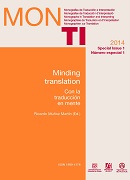The language-(in)dependence of writing skills: translation as a tool in writing process research and writing instruction
Contenido principal del artículo
Resumen
A pilot study was conducted in which 6 students with L1 German had to produce a German version of a text they had composed in their L2 English. The goals were to explore (a) in what respects the ability of advanced university English students to express themselves in their L2 English differs from their ability to do so in their L1 German, and (b) for which aspects of writing the implementation of translation exercises is useful as a tool to improve writing skills. The methods of data collection used were think-aloud and keystroke logging. In the analysis, special emphasis was placed on text-level errors as opposed to formal, lexical and grammatical errors. In their L1 versions, students were consistently able to avoid errors of implicitness and sense but displayed no improvements in other areas such as text coherence and functional sentence perspective. Though some of the errors could be attributed to the special requirements of the translation assignment, translation was also found to have certain advantages that make it a useful tool in writing didactics.
Descargas
Detalles del artículo
La propiedad intelectual de los artículos pertenece a los autores y los derechos de edición y publicación, a la revista. Los artículos publicados en la revista podrán ser usados libremente para propósitos educativos y científicos, siempre y cuando se realice una correcta citación del mismo. Cualquier uso comercial queda expresamente penado por la ley.
Citas
Arndt, Valerie. (1987) “Six writers in search of texts: A protocol-based study of L1 and L2 writing.” ELT Journal 41:4, pp. 257–267.
Bereiter, Carl & Marlene Scardamalia. (1987) The Psychology of Written Composition. Hillsdale, NJ: Lawrence Erlbaum.
Clark, Andy. (1998) Being There: Putting Brain, Body, and World Together Again. Cambridge, MA: MIT Press.
Clark, Andy. (2008) Supersizing the Mind: Embodiment, Action, and Cognitive Extension. Oxford: Oxford University Press.
Clark, Andy & David J. Chalmers. (1998). “The extended mind.” Analysis 58:1, pp. 7–19.
Cumming, Alister. (2001) “Learning to write in a second language: Two decades of research.” International Journal of English Studies 1:2, pp. 1–23.
Devine, Joanne; Kevin Railey & Philip Bischoff. (1993) “The implications of cognitive models in L1 and L2 writing.” Journal of Second Language Writing 2:3, pp. 203–225.
Duncker, Karl. (1945) “On problem-solving.” Psychological Monographs 58:5: pp. 1–114.
Göpferich, Susanne. (1995) Textsorten in Naturwissenschaften und Technik. Pragmatische Typologie – Kontrastierung – Translation. Tübingen: Narr.
Göpferich, Susanne. (2002) “Ein kommunikationsorientiertes Modell zur Bewertung der Verständlichkeit von Texten.” In: Strohner, Hans & Roselore Broose (eds.) 2002. Kommunikationsoptimierung: verständlicher – instruktiver – überzeugender. Tübingen: Stauffenburg, pp. 45–66.
Göpferich, Susanne. (2006) “How successful is the mediation of specialized knowledge? – The use of thinking-aloud protocols and log files of reverbalization processes as a method in comprehensibility research.” HERMES 37, pp. 67–93.
Göpferich, Susanne. (2010) “Data documentation and data accessibility in translation process research.” The Translator 16:1, pp. 93–124.
Göpferich, Susanne & Bridgit Nelezen. (2012) “Data documentation for the article ‘The language-(in)dependence of writing skills: Translation as a tool in writing process research and writing instruction’.” Electronic version available at: http://www.susanne-goepferich.de/ Data_Documentation_Writing_L1_L2.pdf
Göpferich, Susanne & Bridgit Nelezen. (2013) “Die Sprach(un)abhängigkeit von Textproduktionskompetenz: Translation als Werkzeug der Schreibprozessforschung und Schreibdidaktik.” ZfAL – Zeitschrift für Angewandte Linguistik 58:1, pp. 167–200.
Hutchins, Edwin. (1995) Cognition in the Wild. Cambridge: MIT.
Kellogg, Ronald. (2008) “Training writing skills: A cognitive developmental perspective.” Journal of Writing Research 1:1, pp. 1–26. Electronic versión available at: http://jowr.org/articles/vol1_1/JoWR_2008_vol1_nr1_Kellogg.pdf
Kim, Eun-Young. (2011) “Using translation exercises in the communicative EFL writing classroom.” ELT Journal 65:2, pp. 154–160.
Kohro, Yoshifumi. (2009) “A contrastive study between L1 and L2 compositions: Focusing on global text structure, composition quality, and variables in L2 writing.” Dialogue 8, pp. 1–19. Electronic version available at: http://talkwaseda.net/dialogue/no08_2009/2009dialogue08_k1.pdf
Mandelblit, Nili. (1995) “The cognitive view of metaphor and its implications for translation theory.” In: Lewandowska-Tomaszcyk, Barbara & Marcel Thelen (eds.) 1995. Translation and Meaning, Part 3. Maastricht: Hoogeschool Maastricht, pp. 483–495.
MCcutchen, Deborah. (1996) “A capacity theory of writing: Working memory in composition.” Educational Psychology Review 8:3, pp. 299–325.
Roca de Larios, Julio; Rosa M. Manchon & Liz Murphy. (2006) “Generating text in native and foreign language writing: A temporal analysis of problem-solving formulation processes.” The Modern Language Journal 90:1, pp. 100–114.
Schoonen, Rob; Amos van Gelderen; Kees de Glopper; Jan Hulstijn; Annegien Simis; Patrick Snellings & Marie Stevenson. (2003) “First language and second language writing: The role of lingusitic knowledge, speed of processing, and metacognitive knowledge.” Language Learning 53:1, pp. 165–202.
Silva, Tony. (1992) “L1 vs. L2 writing: ESL graduate students’ perceptions.” TESL Canada Journal 10:1, pp. 27–47. Electronic version available at: http://www.eric.ed.gov/PDFS/EJ457628.pdf
Whalen, Karen & Nathan Menard. (1995) “L1 and L2 writers’ strategic and linguistic knowledge: A Model of multiple-level discourse processing.” Language Learning 45:3, pp. 381–418.
Uzawa, Kozue. (1996) “Second language learners’ processes in L1 writing, L2 writing, and translation from L1 into L2.” Journal of Second Language Writing 5:3, pp. 271–294.


